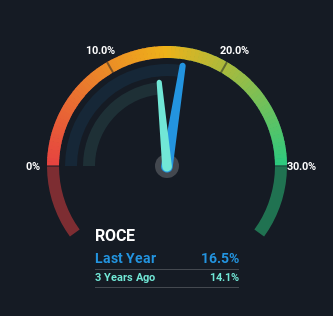- Saudi Arabia
- /
- Trade Distributors
- /
- SASE:9510
Returns On Capital At National Building and Marketing (TADAWUL:9510) Have Hit The Brakes

If you're looking for a multi-bagger, there's a few things to keep an eye out for. One common approach is to try and find a company with returns on capital employed (ROCE) that are increasing, in conjunction with a growing amount of capital employed. Basically this means that a company has profitable initiatives that it can continue to reinvest in, which is a trait of a compounding machine. So, when we ran our eye over National Building and Marketing's (TADAWUL:9510) trend of ROCE, we liked what we saw.
What Is Return On Capital Employed (ROCE)?
Just to clarify if you're unsure, ROCE is a metric for evaluating how much pre-tax income (in percentage terms) a company earns on the capital invested in its business. To calculate this metric for National Building and Marketing, this is the formula:
Return on Capital Employed = Earnings Before Interest and Tax (EBIT) ÷ (Total Assets - Current Liabilities)
0.16 = ر.س73m ÷ (ر.س1.1b - ر.س639m) (Based on the trailing twelve months to June 2024).
So, National Building and Marketing has an ROCE of 16%. That's a pretty standard return and it's in line with the industry average of 16%.
See our latest analysis for National Building and Marketing

Historical performance is a great place to start when researching a stock so above you can see the gauge for National Building and Marketing's ROCE against it's prior returns. If you're interested in investigating National Building and Marketing's past further, check out this free graph covering National Building and Marketing's past earnings, revenue and cash flow.
What The Trend Of ROCE Can Tell Us
While the current returns on capital are decent, they haven't changed much. The company has consistently earned 16% for the last five years, and the capital employed within the business has risen 200% in that time. Since 16% is a moderate ROCE though, it's good to see a business can continue to reinvest at these decent rates of return. Over long periods of time, returns like these might not be too exciting, but with consistency they can pay off in terms of share price returns.
On another note, while the change in ROCE trend might not scream for attention, it's interesting that the current liabilities have actually gone up over the last five years. This is intriguing because if current liabilities hadn't increased to 59% of total assets, this reported ROCE would probably be less than16% because total capital employed would be higher.The 16% ROCE could be even lower if current liabilities weren't 59% of total assets, because the the formula would show a larger base of total capital employed. So with current liabilities at such high levels, this effectively means the likes of suppliers or short-term creditors are funding a meaningful part of the business, which in some instances can bring some risks.
The Bottom Line On National Building and Marketing's ROCE
The main thing to remember is that National Building and Marketing has proven its ability to continually reinvest at respectable rates of return. And the stock has done incredibly well with a 255% return over the last five years, so long term investors are no doubt ecstatic with that result. So while the positive underlying trends may be accounted for by investors, we still think this stock is worth looking into further.
On a separate note, we've found 3 warning signs for National Building and Marketing you'll probably want to know about.
If you want to search for solid companies with great earnings, check out this free list of companies with good balance sheets and impressive returns on equity.
Valuation is complex, but we're here to simplify it.
Discover if National Building and Marketing might be undervalued or overvalued with our detailed analysis, featuring fair value estimates, potential risks, dividends, insider trades, and its financial condition.
Access Free AnalysisHave feedback on this article? Concerned about the content? Get in touch with us directly. Alternatively, email editorial-team (at) simplywallst.com.
This article by Simply Wall St is general in nature. We provide commentary based on historical data and analyst forecasts only using an unbiased methodology and our articles are not intended to be financial advice. It does not constitute a recommendation to buy or sell any stock, and does not take account of your objectives, or your financial situation. We aim to bring you long-term focused analysis driven by fundamental data. Note that our analysis may not factor in the latest price-sensitive company announcements or qualitative material. Simply Wall St has no position in any stocks mentioned.
About SASE:9510
National Building and Marketing
Engages in the wholesale and retail of construction materials in the Kingdom of Saudi Arabia.
Slight with mediocre balance sheet.
Market Insights
Community Narratives



